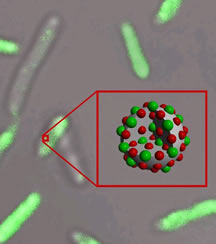Feb 26 2008
Bacteria mutate for a living, evading antibiotic drugs while killing tens of thousands of people in the United States each year. But as concern about drug-resistant bacteria grows, one novel approach under way at the University of North Carolina at Chapel Hill seeks to thwart the bug without a drug by taking a cue from nature.
 Nano-scale scaffolds made of silica and loaded with nitric oxide
Nano-scale scaffolds made of silica and loaded with nitric oxide
Mark Schoenfisch and his lab of analytical chemists at UNC have created nano-scale scaffolds made of silica and loaded with nitric oxide (NO) - an important molecule in mammals that plays a role in regulating blood pressure, neurotransmission and fighting bacterial infections, among other vital functions.
“There was evidence that nitric oxide kills bacteria, but the difficult part involved storing it in a manner such that it could be delivered to bacterial cells,” said Evan Hetrick, a doctoral student in Schoenfisch’s lab and lead author on a paper in the February issue of the American Chemical Society’s journal ACS Nano.
While the body constantly produces NO, and can ramp up its production to fight infection, sometimes it can’t produce enough to mount a sufficient defense. Previous research using small molecules to deliver NO hit roadblocks – controlling the release of the compound was difficult and the molecules were potentially toxic to healthy cells in the body.
“With silica scaffolds, nitric oxide stores easily and we could very carefully control the release,” said Schoenfisch, an associate professor of chemistry in UNC’s College of Arts and Sciences.
Schoenfisch, Hetrick and their colleagues tested their silica scaffolds head-to-head with small molecules against the bacteria Pseudomonas aeruginosa, which is commonly found in burn and other wound infections.
NO delivered by both methods completely killed the bacteria. But the silica nanoparticles delivered the NO right to the bacteria’s doorstep. In contrast, the small molecules released NO indiscriminately, and the concentration of NO is lost as it makes its way toward bacterial cells.
“With the silica particles, more NO actually reached the inside of the cells, enhancing the efficacy of the nanoparticles compared to the small molecule. So, the overall amount of NO needed to kill bacteria is much less with silica nanoparticles,” Schoenfisch said. “And, with small molecules, you’re left with potentially toxic byproducts,” Schoenfisch said. Using mouse cells, they proved that the silica nanoparticles weren’t toxic to healthy cells, but the small molecules were.
Schoenfisch has a history of success with NO-releasing materials. His lab has successfully created a variety of coatings for different biomedical applications. Such materials hold promise as anti-infective coatings and as methods to improve the body’s integration of biological implants – such as hip or knee joints – and implanted sensors that relay various biological measures, such as blood glucose or oxygen concentrations.
The amount and rate of NO release are easily modified and controlled by using these different silica nanoparticles. “Release rates are a function of the precursors used to make the nanoparticles,” Schoenfisch said. “It depends entirely on how we build the silica structures.”
Future research will include studying additional bacterial strains, active targeting, preferential uptake and biodistribution studies.
www.chem.unc.edu/